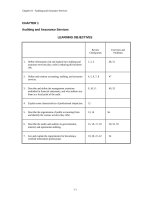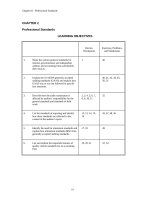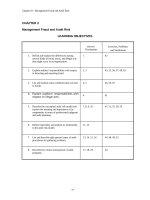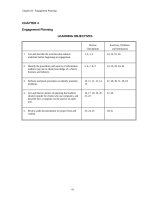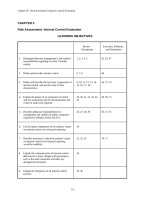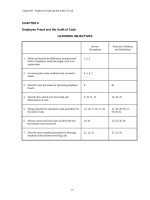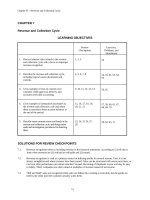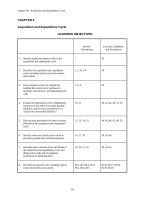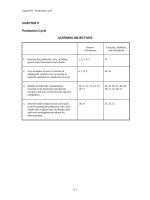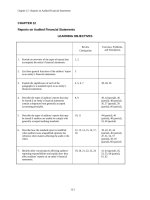Solution manual cost and managerial accounting by barfield 3rd activity based cost systems for management
Bạn đang xem bản rút gọn của tài liệu. Xem và tải ngay bản đầy đủ của tài liệu tại đây (62.11 KB, 28 trang )
Chapter 4
Activity-Based Cost Systems for Management
Questions
1.
Activity-based management is a management approach that
associates the activities executed by an organization with the
value customers derive from products. Efficiency and
effectiveness are achieved by reducing the level of activities
that do not create value for the customer and by improving
execution of activities that do create customer value.
Specific tools beneath the ABM umbrella include activity
analysis, cost driver analysis, activity-based costing,
continuous improvement, operational control, performance
evaluation, and business process reengineering.
2.
Value-added activities increase the worth of a product or
service to the consumer. Non-value-added activities increase
the time spent on a product or service but do not increase its
worth to the consumer. Performing any task required for
production (adding materials, blending, molding, assembling,
etc.) is an example of a value-added activity; moving
partially completed units of inventory, storing those parts,
inspecting for quality, and having parts waiting to be worked
on are examples of non-value-added activities.
3.
Value-added activities are viewed from the customer's
perspective because it is the customer who is the end
evaluator of the “worth” of a product or service and,
therefore, the activities involved in creating that product or
service.
4.
Identifying non-value-added activities provides management the
opportunity to minimize or eliminate such activities. As nonvalue-added activities are reduced or eliminated, the costs
associated with these activities can be reduced or eliminated
which will allow the company to either reduce prices to
consumers or to make a higher profit if selling prices are
maintained.
75
76
Chapter 4
Activity-Based Cost Systems for Management
5.
In a televised football game, the value-added activities are
the actual game plays. Non-value-added activities consist of
commercials and the time between plays. Activities such as
“moving the chains,” measuring to determine if a first down
was made, moving the ball from the end of one play to the
point where it will be put in play next are all non-valueadded activities. People who believe that the commercials are
informative and interesting and that the time between plays
allows them an opportunity to examine the strategies of the
teams and project what each team is likely to do on the next
play may disagree with this assessment.
6.
A process map illustrates, sequentially, all of the steps
associated with accomplishing a specific task. By carefully
studying the steps, value-added and non-value-added activities
can be identified and ideas can be generated to reduce or
eliminate the non-value-added activities.
7.
The MCE is a measure of production efficiency. It is
expressed as value-added processing time divided by total
cycle time. The numerator refers to the actual time it takes
to physically manufacture a unit. Total cycle time is defined
as value-added time plus all time spent on non-value-added
activities (inspection time, transfer time, and idle time).
In an optimized manufacturing environment, all non-value-added
activities would be eliminated so the value of the MCE would
be 100 percent.
8.
A cost driver is an action or condition that directly
influences and creates costs. Cost drivers are used as bases
for allocating costs to activity centers and to products.
Cost drivers in a production activity center may include
number of setups, physical layouts, and number of defects. In
purchasing, cost drivers may include number of purchase
orders, number of different items purchased and number of
suppliers.
9.
Yes, cost drivers exist in traditional accounting systems
although they are called "bases for allocation."
In traditional systems, a single cost driver such as
direct labor hours or machine hours is commonly used rather
than multiple cost drivers. Also in traditional systems,
volume-based cost drivers are more the norm than
non-volume-based (e.g., square footage) cost drivers.
Finally, traditional accounting stresses finding an allocation
base that demonstrates strong statistical correlation to the
cost, but ABC emphasizes searching for multiple cost drivers
that bear cause-and-effect relationships to the cost.
10.
Chapter 4
77
Activity-Based Cost Systems for Management
Activity analysis is used to separate activities into two
groups: those that add value to the product or service and
those that do not add value. Once the non-value-adding
activities are identified, managers seek to reduce or
eliminate the level of the drivers of those activities. If
such efforts are successful, non-value-adding costs will be
reduced without impairing the value of products or services to
the consumer. The result should be an increase in profits.
11.
Activity-based costing is a system that collects financial and
operational data on the basis of the underlying nature and
extent of business activities. ABC attaches costs to products
based on the activities (cost drivers) performed to produce,
distribute, or support those products. It differs from
traditional product costing in the extent to which multiple
cost drivers are used at multiple organizational levels to
allocate indirect production costs. Costs are more likely to
be allocated to production based on the activities that cause
those costs in an activity-based costing system than in a
traditional costing system. The result should be a more
accurate reflection of product cost.
12.
By using a single cost pool and a single cost driver to
allocate overhead, the more traditional methods of overhead
assignment ignore the influence on cost of the different
activities that occur to make a product. In this manner,
low-volume specialty products, which cause a disproportionate
amount of overhead, are only assigned an average charge for
overhead, thereby shifting costs to the standard product
lines. ABC does a better job of tracing costs to the products
that caused the various costs by using multiple cost pools and
multiple cost drivers.
13.
The organizational characteristics include: provision of a
wide variety of products or services; large overhead costs not
proportional to the unit volume of individual products;
significant automation reducing the usefulness of direct labor
as a base for allocating overhead; and difficult-to-explain
product profit margins.
14.
Activity-based costing requires costs to be aggregated at
different levels because the activities that cause costs to be
generated occur at different levels. Only if costs are
accumulated on the same level as the activity that generates
them can an allocation base be selected that represents a
cause-effect relationship between the cost and the cost pool.
78
15.
Chapter 4
Activity-Based Cost Systems for Management
Benefits of activity-based costing include these:
• Focusing on value-added and non-value-added activities to
minimize those activities not adding value;
• Highlighting interrelationships among areas;
• Providing feedback on product design and opportunities for
process improvements;
• Encouraging use of nonfinancial measures of activity and
performance; and
• Providing a more appropriate means of charging overhead to
products.
These benefits of ABC should result in a reduction in costs
because of the improved understanding of which activities
cause costs to be generated, the increased focus on
controlling such activities, and the evolution of improved
performance measures so that measured performance is more
highly correlated with cost control.
16.
The view of proponents of ABC is that, in the long run, all
costs are variable. Costs traditionally labeled as fixed are
really costs that vary with long-term cost drivers rather than
short-term cost drivers. Thus, ABC proponents argue that
there are no fixed costs only long-term variable costs and
short-term variable costs.
17.
Attribute-based costing extends the concept of activity-based
costing by relating the company's costs to the characteristics
(attributes) of a product that create value for the consumer.
By comparing the cost of a value-enhancing characteristic to
its benefits (price the consumer is willing to pay), the
company can make correct judgments about which characteristics
to add to the product and which to leave out.
18.
All companies are not likely to benefit equally from adopting
ABC. The greatest benefits are likely to be gained by firms
with complex production processes; firms that produce products
that vary relative to cost, complexity, and volume; and firms
that have a high level of overhead costs that are fixed
relative to production volume.
19.
Implementation of ABC requires a significant commitment of
time and resources. Significant time is consumed identifying
cost drivers and determining how to split production costs
into pools that are relatively homogeneous relative to a
particular cost driver. Identification of these cost drivers
typically requires internal surveys and interviews with
company personnel. Additional time is consumed evaluating,
selecting, and implementing the software to manage the ABC
data collection and cost assignments.
Chapter 4
Activity-Based Cost Systems for Management
79
Exercises
20.
a.
b.
c.
d.
e.
f.
g.
h.
i.
j.
21.
a.
b.
c.
d.
e.
f.
g.
h.
i.
j.
4
2
5
1
8
7
6
9
3
10
22.
a.
None of the items are value-added activities; products
should be designed so that schedule changes should not be
needed.
b.
Number of factory schedule changes is the driver.
c.
Eliminate factory schedule changes except for those asked
for by a customer (in which case the customer should be
charged for the cost of the change) or for critical
changes necessary to realize significant quality
improvements and cost reductions.
a.
Cycle time = 30 + 18 + 3,580 + 15 + 90 + 80 + 75 + 20
+ 5,040 + 25 = 8,973 minutes
b.
MCE = (90 + 80 + 75) ÷ 8,973 = 2.7%
c.
The company could do many things to improve its MCE. The
biggest areas to concentrate on are the time spent
storing ingredients in the stock room and the time spent
storing bottled dressing in the warehouse. Probably the
most significant improvement in MCE would come from
adopting JIT management of all inventories. This would
allow the firm to concentrate on reducing total cycle
time by not purchasing materials until they are needed
and not producing finished goods until they are demanded
by customers.
23.
8
7
4
1
10
6
3
5
2
9
Chapter 4
Activity-Based Cost Systems for Management
80
24.
a.
b.
c.
d.
e.
f.
g.
h.
i.
j.
25.
a.
b.
c.
d.
e.
f.
g.
h.
i.
j.
k.
26.
a.
O
U
B
B
O
P
U (could be product/process if left on all the time)
O
P
P
machine hours (for maintenance related to the volume of
usage of machinery), average age of equipment (for
obsolescence and age-related maintenance)
machine hours (for machine-driven usage), outside air
temperature (for weather-related usage)
number of transactions processed (valid volume measure)
number of product defects (volume of quality defects),
pounds of scrap and waste (volume of quality defects),
number of quality inspections (number of batches)
pounds of material processed (volume of work processed),
number of different types of material handled (complexity
of material handling), number of purchase orders (volume
of work processed by staff and number of suppliers used)
average amount of material inventory (volume of material
stored), square footage of storage area (storage
capacity)
amount of investment in factory machinery and buildings
(total cost basis for depreciation)
number of setups (volume driver), total time of setups
(alternative volume measure)
number of engineering changes (volume of engineering
changes), number of process changes (volume of changes to
the manufacturing processes), number of engineering
change orders (number of requests for changes to products
and processes)
number of print ads (volume measure), seconds of air time
(cost measure), number of new ads developed (measure of
professional time)
pounds of materials received (volume measure), distance
of average shipment received (cost driver for commercial
freight carriers)
Allocation rate = Cost ÷ Allocation base
Contracts rate = $200,000 ÷ 10,000 = $20 per contract
page
Regulation rate = $250,000 ÷ 500 = $500 per review
request
Court rate = $350,000 ÷ 3,000 = $117 per professional
hour
b.
27.
Chapter 4
Activity-Based Cost Systems for Management
Contracts: 1,000 × $20
$20,000
Regulation: 15 × $500
7,500
Court: 250 × $117
29,250
Total
$56,750
c.
The rates will be used to bill other departments for the
costs incurred in the legal department. If the legal
department operates efficiently, its billings should
equal or exceed the costs it incurs.
The firm can hire an outside law firm to perform the
legal work rather than do the work internally. It is
difficult to determine, without more information, how
this action would affect total costs. However, it would
tend to make the legal costs much more variable and less
fixed.
a.
$400,000 ÷ 200,000 calls = $2 per call
$200,000 ÷ 25,000 purchase orders = $8 per purchase order
$90,000 ÷ 15,000 receiving reports = $6 per receiving
report
Cost assignment:
230 calls × $2
80 purchase orders × $8
25 receiving reports × $6
28.
81
$
460
640
150
$1,250
b.
$1,250 ÷ 332 units = $3.77 (rounded) per unit
a.
$1,200,000 ÷ $20 per hour = 60,000 direct labor hours
$4,000,000 ÷ $20 per hour = 200,000 direct labor hours
Overhead = $2,210,000 + $1,612,000 = $3,822,000
Overhead rate = $3,822,000 ÷ (60,000 + 200,000) = $14.70
Revenue
less:
Direct materials
Direct labor
Overhead
Profit (loss)
Lawn Mowers
$8,000,000
Garden Tractors Total
$8,800,000
$16,000,000
(2,000,000)
(1,200,000)
(882,000)*
$3,918,000
(1,800,000)
(3,800,000)
(4,000,000)
(5,200,000)
**
(2,940,000)
(3,822,000)
$
60,000
$ 3,978,000
Number of units
50,000
Profit per unit
$78.36
* $14.70 ×60,000 = $882,000
** $14.70 × 200,000 = $2,940,000
10,000
$6
82
b.
Chapter 4
Activity-Based Cost Systems for Management
Overhead rate = $2,210,000 ÷ 260,000 = $8.50 per DLH
Lawn Mowers
Garden Tractors
Total
Revenue
$ 8,000,000
$ 8,800,000 $16,800,000
less:
Direct materials (2,000,000)
(1,800,000) (3,800,000)
Direct labor
(1,200,000)
(4,000,000) (5,200,000)
*
Overhead
(510,000)
(1,700,000)** 2,210,000)
Administration
(1,612,000)
Profit (loss)
$4,290,000
$ 1,300,000 $ 3,978,000
Per unit
$85.80
$130
*
**
29.
$8.50 × 60,000 = $510,000
$8.50 × 200,000 = $1,700,000
c.
The profit per unit in (b) provides a better picture. In
part (a), there was no logical basis for using direct
labor hours to allocate administrative expenses.
Accordingly, any measure profit that relies on such an
allocation is not meaningful
a.
It is obvious that the production process in this company
has a significant amount of non-value-added time built
into the cycle time. The most likely cause of this nonvalue-added time is one or more bottleneck processes that
create long wait periods when no production is occurring
and goods are simply stored or stacked until they can
pass through the process.
A fairly simple way to determine where the
bottlenecks are is to walk through the plant and see
where materials or partially completed units are being
stacked in sight or being brought back into the
production area from a storage location. Another
indicator of a bottleneck is where labor is waiting for a
machine to complete a process so that additional
materials can be input.
In addition to bottlenecks, the company could be
engaging in rush orders that remove regularly scheduled
production from processing. Always trying to catch up on
backorders will create delays in processing current
orders. It is possible that if all backorders were
filled, the current orders could be processed at a much
more rapid pace. Finally, defective units caused by
rushing to complete orders will have to be reworked,
thereby causing an even longer delay in processing time.
b.
A value chart allows a company to analyze all activities
that comprise total cycle time. The role of the value
chart is to identify those activities that do not add
value in the eyes of the consumer. By focusing
managerial attention on reducing or eliminating such
activities, total cycle time is reduced and total costs
are reduced.
30.
31.
a.
Chapter 4
83
Activity-Based Cost Systems for Management
As variety in products increases, costs will also
increase. Thus, the shift to small special orders will
increase costs in purchasing (more orders, more calls to
get prices, more space required for catalogs, etc.),
receiving (more orders and receipts to handle and account
for), storage (different products must be grouped
together and differentiated from other products for easy
accessibility), accounting (more inventory to account
for, potentially more suppliers to pay), customer service
(new larger catalogs, possible complaints from customers
receiving wrong or slightly wrong orders, more time for
sales calls), production scheduling (variety in setups,
increase in movement of materials depending on production
run), and laboratory work (research and development tests
incurred to make certain that the products meet the
appropriate environmental and technical requirements).
b.
Yes, it is very possible that management is correct in
its belief because total overhead costs are typically
allocated to products based on some single allocation
base such as direct labor hours or machine hours. These
single allocation bases do not reflect the actual causeand-effect relationships between cost drivers and
overhead costs.
c.
The memo should suggest that management consider the use
of multiple overhead allocation bases and activity-based
costing. This method of overhead allocation attempts to
more fairly attach costs to the products and/or services
that actually caused the costs to be incurred.
a.
The traditional cost system, developed to value
inventory, distorts product cost information because the
cost system
was designed to value inventory in the aggregate and
not relate to product cost information;
uses a common departmental or factory-wide measure
of activity, such as direct labor hours or dollars,
now a small portion of overall production costs, to
distribute manufacturing overhead to products;
deemphasizes long-term product analysis (when fixed
costs become variable costs); and
causes managers, who are aware of distortions in the
traditional system, to make intuitive, imprecise
adjustments to the traditional cost information
without understanding the complete impact.
84
b.
c.
d.
Chapter 4
Activity-Based Cost Systems for Management
Outlined below are the purpose and several
characteristics of the two noted cost systems:
1.
Inventory measurement
Meets external reporting requirements for
aggregate balance sheet valuation and income
determination.
Provides monthly and quarterly reporting.
2.
Activity-based costing
Differentiates costs between value-added and
non-value-added activities.
Assigns costs to products according to
activities involved in the production process
that cause these costs.
The benefits that management can expect from
activity-based costing include the following:
Leads to a more competitive position by
evaluating activity costs, i.e., costs
associated with the complexity of the
transaction rather than the production volume
and the cost drivers that cause the activities.
Streamlines production processes by reducing
non-value-added activities, thereby creating
reduced setup times, optimal plant layout, and
improved quality.
Provides management with a more thorough
understanding of product costs and product
profitability for strategies and pricing
decisions.
Highlights interrelationships among activities.
Provides feedback for opportunities for
improvements in product design and production
processes.
Encourages use of nonfinancial measures of
activity and performance.
Provides a more appropriate means of assigning
overhead to products.
The steps that a company, using a traditional cost
system, would take to implement activity-based costing
include these:
Identify activity centers and cost drivers.
Assign costs to activity center cost pools
using appropriate first-stage cost drivers.
Assign activity center cost pools to products,
services, or other cost objects using
appropriate second-stage cost drivers,
according to level of cost (unit, batch,
products, process, and organizational levels).
(CMA adapted)
Chapter 4
Activity-Based Cost Systems for Management
85
Problems
32.
33.
a.
Value-added activities
Remove sod and level site
Build forms
Mix and pour concrete
Level concrete and smooth
Remove forms
Total
Time
10
12
5
2
1
30 hours
b.
Non-value-added activities
Purchase materials
Obtain rental equipment
Drying time
Return rental tools
Clean up
Total
c.
Total cycle time = 30 + 33 = 63 hours
MCE = 30 ÷ 63 = 47.6%
a.
Value-added activities
Measuring and cutting
Assembling
Building fireplace
Pegging logs
Cutting & framing doors and windows
Sealing joints
Total production time (days)
Time
3
7
9
4
2
4
29
b.
Non-value-added activities
Receiving
Storage
Handling
Setting up & moving scaffolding
County inspections
Total nonproduction time (days)
Time
1
5
7
6
3
22
c.
Total cycle time = 29 + 22 = 51 days
Time
5
3
22
1
2
33 hours
MCE = 29 ÷ 51 = 56.9%
d.
The value-added activities are those that increase the
worth of the product or service in the eyes of the customer
and for which the customer is willing to pay. Non-valueadded activities are those activities that do not increase
the value of the product in the eyes of the consumer.
86
34.
a.
Chapter 4
Activity-Based Cost Systems for Management
Umbrellas: $8 × 100,000
$ 800,000
Gazebos:
$60 × 10,000
Lawn chairs: $20 × 30,000
Total
b.
600,000
600,000
$2,000,000
Allocation rates:
Quality control: $100,000 ÷ 140,000 = $.7143 per unit
Setups: $100,000 ÷ 1,000 = $100 per setup
Materials handling: $300,000 ÷ 2,000,000 = $.15 per lb.
Equipment operation: $1,500,000 ÷ 1,000,000 = $1.50 per
MH
Cost allocation:
Umbrellas
Quality control
$0.7143 × 100,000
$0.7143 × 10,000
$0.7143 × 30,000
Setups
$100 × 200
$100 × 400
$100 × 400
Materials handling
$.15 × 400,000
$.15 × 1,000,000
$.15 × 600,000
Equipment operation
$1.50 × 200,000
$1.50 × 400,000
$1.50 × 400,000
Total overhead*
Number of units
Cost per unit
Total cost per unit:
DM
DL
OH
Total
*
c.
Total allocations
Gazebos
Lawn Chairs
$ 71,430
$
7,143
$ 21,427
20,000
40,000
40,000
60,000
150,000
90,000
300,000
600,000
$451,430
100,000
$4.51
$4.00
6.00
4.51
$14.51
$797,143
10,000
$79.71
$40.00
45.00
79.71
$167.71
600,000
$751,427
30,000
$25.05
$ 4.00
15.00
25.05
$44.05
= $451,430 + $797,143 + $751,427
= $2,000,000
Relative to the prices developed based on the costs of
the products found using activity-based costing, costs
under the traditional costing system would generate lower
prices for umbrellas and higher prices for the other two
products.
35.
a.
b.
Chapter 4
Activity-Based Cost Systems for Management
Total overhead
Indirect labor
Dept. 1 ($681,000 - $375,000)
$ 306,000
Dept. 2 ($462,000 - $200,000)
262,000
Machine ($400,000 + $800,000)
1,200,000
Power
400,000
Building
1,000,000
Purchasing
100,000
Total
$3,268,000
87
Total DLHs = Dept. 1 + Dept. 2 = 25,000 + 10,000 = 35,000
$3,268,000 ÷ 35,000 = $93.37 per DLH
c.
Product A
Product B
DM
$ 400,000
$ 600,000
DL:
Dept. 1 (4/5, 1/5) $300,000
$ 75,000
Dept. 2 (1/2, 1/2)
100,000
400,000 100,000
175,000
OH(@ $93.37 per DLH)
2,334,250
933,700
Total cost
$3,134,250
$1,708,700
Number of units
10,000
10,000
Cost per unit
$313.43
$170.87
*Product A = 20,000 + 5,000 = 25,000; Product B = 5,000 + 5,000
= 10,000
d.
Building Occupancy: $1,000,000 ÷ 500,000 = $2 per sq. ft.
Purchasing (10,000 × $2)
$ 20,000
Power (40,000 × $2)
80,000
Dept. 1 (200,000 × $2)
400,000
Dept. 2 (250,000 × $2)
500,000
Purchasing: Direct costs ($100,000) + Allocated building
occupancy ($20,000) = $120,000, divided by 500 purchase
orders = $240 per purchase order
Material X: 200 × $240 = $48,000
Material Y: 300 × $240 = $72,000
Power: Direct costs ($400,000)
occupancy ($80,000) = $480,000,
$0.048 per kW
Department 1: 1,500,000 ×
Department 2: 8,500,000 ×
+ Allocated building
divided by 10,000,000 kW =
$0.048 = $ 72,000
$0.048 = 408,000
88
e.
Chapter 4
Activity-Based Cost Systems for Management
Product A
Indirect labor
Department 1 ($306,000)
(Total indirect LHs for A =
2,500 + 5,000 + 200 = 7,700)
(Total indirect LHs for B =
2,500 + 10,000 + 200 = 12,700)
Total indirect LHs = 20,400
(7,700 ÷ 20,400 = 38%)
$116,280
(12,700 ÷ 20,400 = 62%)
Department 2 ($262,000)
(Total indirect LHs for A =
2,500 + 1,000 + 200 = 3,700)
(Total indirect LHs for B =
5,000 + 4,000 + 400 = 9,400)
Total indirect LHs = 13,100
(3,700 ÷ 13,100 = 28%)
(9,400 ÷ 13,100 = 72%)
Product B
$
189,720
73,360
188,640
Power
Total MHs in Dept. 1 = 5,000 + 10,000
= 15,000
Department 1 $72,000 (Product A,
1/3; Product B, 2/3)
24,000
48,000
Total MHs in Dept. 2 = 5,000 + 20,000
= 25,000
Department 2 $408,000 (Product A,
1/5; Product B, 4/5)
81,600
326,400
Machinery-related (same basis as Power)
Department 1 (1/3, 2/3)
133,333
Department 2 (1/5, 4/5)
160,000
266,667
640,000
Building occupancy (same basis as Power)
Department 1 (1/3, 2/3)
133,333
Department 2 (1/5, 4/5)
100,000
266,667
400,000
Purchasing
Total lbs. of X = 50,000 + 50,000
= 100,000
Total lbs. of Y = 100,000
Material X $48,000 (Product A, 1/2;
Product B, 1/2)
24,000
Material Y $72,000 (all Product B)
0
Overhead cost
$845,906
24,000
72,000
$2,422,094
f.
Chapter 4
Activity-Based Cost Systems for Management
Product A
Raw material X (1/2, 1/2)
$ 400,000
Raw material Y (all B)
0
Direct labor - Dept. 1 (4/5, 1/5)
300,000
Direct labor - Dept. 2 (1/2, 1/2)
100,000
Overhead (from part e)
845,770
Total product costs
$1,645,770
Cost per unit
$164.58
89
Product B
400,000
200,000
75,000
100,000
2,422,230
$3,197,230
$319.72
$
[Adapted from Roth and Borthick, "Getting Closer to Real Product
Costs," Management Accounting (May 1989), pp. 28-33.]
36.
a.
Predetermined rate using machine hours:
$6,000,000 ÷ 1,000,000 MHs = $6 per MH
b.
Cost per door:
Direct material
$100,000
Direct labor
300,000
Applied overhead (10,000 × $6)
60,000
Total cost
$460,000
Divided by number of stores
5,000
Cost per door = $460,000 ÷ 5,000 =
$92.00
c.
Predetermined rate per activity per unit of cost driver:
Electric power:
$500,000 ÷ 100,000 = $5.00 per kilowatt hour
Work cells:
$3,000,000 ÷ 600,000 = $5.00 per square foot
Material handling:
$1,000,000 ÷ 200,000 = $5.00 per material move
Quality control inspections:
$1,000,000 ÷ 100,000 = $10.00 per inspection
Product runs:
$500,000 ÷ 50,000 = $10.00 per production run
Cost per door:
Direct material
Direct labor
Applied overhead
Electric power ($5.00 X 1,000)
Work cells ($5.00 X 8,000)
Materials handling ($5.00 X 100)
Quality Control ($10.00 X 50)
Product Runs ($10.00 X 25)
Total costs
Divided by number of doors
Cost per door
$100,000
300,000
$
5,000
40,000
500
500
250
46,250
$446,250
5,000
$89.25
90
Chapter 4
Activity-Based Cost Systems for Management
d.
The activity-based costing method allocates the cost
pools of manufacturing overhead to various cost drivers
and then to products based on the amount or number or
other bases that each product consumes in various cost
drivers. Assume that Garage Door Company's policy is to
add 40% to manufacturing costs as gross profit to cover
costs such as administrative expenses, selling expenses,
financial expenses and research and development expenses,
and the remainder will be a profit. In determining the
selling price of the door under both methods, add 40 % of
total manufacturing costs:
Present Costing System ABC System
Unit costs
$ 92.00
$ 89.25
Plus gross profit 40%
36.80
35.70
Selling price
$128.80
$124.95
It is evident that a selling advantage results from
the ABC method. As illustrated in this case, the ABC
method should result in a pricing decision that makes the
company more competitive in the marketplace. Savings in
applying manufacturing overhead costs to products will
enable the company to sell its products at a lower price
than competitors while maintaining the same gross margin
ratio.
[Copyright 1990 IMA (formerly NAA)]
37.
a.
Base wages: $42,000,000 ÷ 2,100,000 = $20 per DLH
Health care: $7,000,000 ÷ 1,400 = $5,000 per worker
Payroll taxes: $3,360,000 ÷ $47,800,000 = $0.07 per
dollar of total wages
Overtime: $5,800,000 ÷ 8,000,000 = $0.725 per unit
Training: $1,250,000 ÷ 200 = $6,250 per new hire
Retirement: $4,600,000 ÷ 1,400 = $3,285.71 per worker
Workers' comp.: $800,000 ÷ 1,400 = $571.43 per worker
b.
Although more labor-related items are driven by the
number of factory workers, the number of regular labor
hours accounts for most of the labor cost, $42,000,000.
c.
It can be inferred that the use of overtime hours
minimizes some cost drivers. In this example, use of
overtime hours would help contain health care costs,
training costs, retirement costs, and workers'
compensation.
38.
39.
a.
Chapter 4
Activity-Based Cost Systems for
Professional salaries: $900,000 ÷
Building costs: $450,000 ÷ 15,000
Risk management: $320,000 ÷ 1,000
91
Management
30,000 = $30 per hr.
= $30 per sq. ft.
= $320 per patient
b.
Surgery = (6,000 × $30) + (1,200 × $30) + (200 × $320)
= $280,000
Housing = (20,000 × $30) + (12,000 × $30)
+ (500 × $320) = $1,120,000
Outpatient care = (4,000 × $30) + (1,800 × $30)
+ (300 × $320) = $270,000
c.
Surgery: professional hours (this is an activity base
that would drive many costs related to surgery and would
be easy to track)
Housing patients: days in hospital (this activity base
would be easy to follow and would account for use of time
and space)
Outpatient care: professional hours (this would capture
service provision to outpatients); or expected patient
volume (this would capture those costs that are more
related to capacity to provide service)
a.
Allocation rates:
Utilities: $300,000 ÷ 60,000 = $5 per MH; assigned
to products using 30,000, 10,000, and 20,000,
respectively
Scheduling & setup: $273,000 ÷ 780 = $350 per setup;
assigned to products using 130, 380, and 270,
respectively
Materials handling $640,000 ÷ 1,600,000 = $0.40 per
lb.; assigned to products using 500,000, 300,000, and
800,000, respectively
Products
A
B
C
Direct costs
$ 80,000
$ 80,000
$ 90,000
Utilities
150,000
50,000
100,000
Scheduling & setup
45,500
133,000
94,500
Material handling
200,000
120,000
320,000
Total
$475,500
$383,000
$604,500
Units produced
40,000
20,000
60,000
Cost per unit
$11.89
$19.15
$10.075
b.
Total overhead = $300,000 + $273,000 + $640,000
= $1,213,000
Total DLHs = 32,000 + 18,000 + 50,000 = 100,000
Overhead rate = $1,213,000 ÷ 100,000 = $12.13
1.
Products
A
B
C
Direct costs
$ 80,000
$ 80,000
$ 90,000
Overhead*
388,160
218,340
606,500
Total
$468,160
$298,340
$696,500
Divided by units
40,000
20,000
60,000
Unit costs
$11.70
$14.92
$11.61
*Assigned at 32,000, 18,000, and 50,000
respectively, times $12.13
2.
c.
Product A:
Product B:
Product C:
Conventional
$11.70 × 1.20 = $14.04
$14.92 × 1.20 = $17.90
$11.61 × 1.20 = $13.92
Product A:
Product B:
Product C:
ABC
$11.89 × 1.20 =
$19.15 × 1.20 =
$10.08 × 1.20 =
$14.27
$22.98
$12.10
The conventional approach to product costing used only
one allocation base, direct labor hours. This allocation
base was unable to fully capture the causes of overhead
cost incurrence. The ABC approach developed better
overhead allocation because of the superior relationship
between the cost pools and the cost drivers used to
allocate the overhead cost.
To the extent that there is error in determining
costs, there will also be mispricing when prices are set
based on costs as is evident in this problem. Although
Product A is relatively unaffected by the choice of
costing system, Products B and C have substantially
different costs and prices under the two systems. The
traditional costing system would result in underpricing
Product B and overpricing Product C. This would affect
both sales volume and company profitability.
73
Chapter 4
Activity-Based Cost Systems for Management
93
Cases
40.
a.
Although difficult to quantify, some costs are associated
with just carrying a part number in the database. Each
part number must be originally set up in the system, built
into the structure of a bill of materials, and maintained
until it is no longer used. Moreover, each part must be
planned, scheduled, negotiated with vendors, purchased,
received, stored, moved, and paid for. Having two parts
similar enough that one could be used for both applications
requires unnecessary duplication of these activities and,
therefore, unnecessary costs.
Standardizing parts results in several indirect
benefits. Fewer unique part numbers usually means fewer
vendors and greater quality of delivered parts. It also
means smoother JIT production, fewer shutdowns of
manufacturing lines, and greater field reliability.
b.
To appropriately influence the behavior of design and
cost-reduction engineers, the MOH allocation method should
assign little cost to products for each high-usage common
part and more cost for each low-usage unique part, in
proportion to the total usage of the parts.
Annual Cost to Carry =
Budgeted MOH Costs
Each Part Number
# of Active Part Numbers
MOH Rate for
the Part Number
=
Annual Cost to Carry Each Part Number
Annual Usage of a Part Number
Annual Cost to Carry = $5,500,000 ÷ 8,000 = $687.50
MOH Rate for High-Usage Part = $687.50 ÷ 35,000 = $.02
MOH Rate for Low-Usage Part = $687.50 ÷ 200 = $3.44
The MOH cost for each product is based on the part
numbers in its bill of materials. The rate for each part
number is multiplied by the number of times the part is
used in the product. The resulting amounts are then
aggregated for all part numbers in the bill of materials.
The greater the number of parts in a product and the higher
the percentage of unique parts, the greater the amount of
allocated cost.
94
c.
d.
Chapter 4
Activity-Based Cost Systems for Management
Students will discuss the appropriateness of the allocation
bases they selected, the ways in which their methods would
communicate accurate information to design and
cost-reduction engineers concerning the indirect costs of
engineering products with unique versus common parts, and
the need to provide those engineers with incentives to use
the information in their part selection decisions.
Regarding the latter point, engineers at Tektronix,
are in fact evaluated on the costs of the products they
design. Although they are driven by emerging technologies
and other considerations such as quality and customer
needs, the evaluation process motivates them to seek
minimum cost designs consistent with these considerations.
With the part number-based MOH allocation method,
engineers will tend to design products differently. The
product costing system will tell them that engineering
low-volume unique parts into products causes overhead.
Having the material overhead cost associated with each
individual part number will help engineers to evaluate the
use of a new part versus an existing part. Knowing the
previously hidden costs of components, the engineers can
properly assess not only the tradeoffs between parts
proliferation and direct labor reduction but also the cost
of selecting a unique component to satisfy a specific
functional requirement of a customer.
A MOH allocation method should provide accurate estimates
of the long-run variable costs of all of the demands made
on the organization's material-related overhead resources
by each product in the product line. To approach 100 %
accuracy, the MOH cost pool would have to be decomposed
into smaller homogeneous cost pools in which cost
variations could be explained by a single cost driver.
The resulting costing system would be marginally more
accurate but substantially more complex, difficult to
understand, and more costly to maintain than the
single-cost-pool method that was decided on in this
situation. Also, adding more cost drivers to the system
would probably have initially created confusion and
definitely would have been resisted by manufacturing,
engineering, and marketing personnel.
Manufacturing costs are a crucial element of
profitability in highly competitive markets of complex
products. It is therefore very important that the
benefits of more accurate tracing of costs to products
exceed the cost of achieving the incremental accuracy
(for example, the costs of determining and measuring
additional cost drivers). It would be counterproductive
to implement an elaborate overhead allocation system to
cost products with very high accuracy if the system would
cost so much to maintain that the companies would become
less, not more, competitive. A single-cost-driver method
may be a compromise that reflects the costs and benefits
Chapter 4
95
Activity-Based Cost Systems for Management
of achieving additional accuracy.
A final consideration related to accuracy is the
proper interpretation of computed rates. The $687.50
annual cost to carry each part number is not a short-term
variable cost. Most of the costs in the MOH cost pool
are fixed in the short term on a unit volume basis.
Elimination of one part number in the database therefore
will not immediately reduce the total material-related
overhead cost by this amount. Nor in the case of the
low-usage part will using one less save $3.44 in
out-of-pocket costs. These rates reflect a long-term
perspective; the company believes that, by supporting the
manufacturing strategy, the allocation method will lead a
to real cost savings over time as the next generation of
products is designed with fewer different part numbers.
e.
The costs of all demands made by products on both
manufacturing and non-manufacturing resources are proper
elements of product costs used for management decisions,
whereas inventory values for external reporting consist
of manufacturing costs only. The MOH cost pool includes
some or all of the costs of three types of cost areas.
Because all such costs areas are manufacturing related,
their costs are appropriately assigned to inventory, and
the accurate MOH allocation method is an appropriate
technique for making the assignments.
The company, however, decided to use the MOH rates
as "management costs" only and to continue to use the old
allocation method to compute "financial costs." One
factor that led to this decision was the company's desire
to value inventory consistently. If the new method were
used to compute financial costs, the reported inventory
valuations would change because, among other reasons,
more manufacturing support costs would be allocated to
products.
A more compelling reason for the "two sets of costs"
approach is the need to maintain flexibility in product
costing. The part number-based MOH allocation method was
developed to modify behavior to enact the strategy of
parts standardization. It will cease to be an effective
behavioral tool when design and cost-reduction engineers
fully understand the costs of part number proliferation
and naturally design products with common parts to the
extent each situation allows. After parts
standardization becomes second nature to engineers,
management will change its strategy and the accounting
staff will develop a new product costing method to
support the new strategy. In this way, product costs can
continue to be effective management tools for influencing
behavior without affecting the accountants' ability to
value inventory on a consistent basis.
[Michael A. Robinson, ed. Cases from Management Accounting
Practice No. 5 Instructor's Manual (Montvale, NJ: National
96
Chapter 4
Activity-Based Cost Systems for Management
Association of Accountants, 1989). pp. 7-11, adapted.]
41.
a.
Advantages associated with activity-based costing systems
include:
*
highlighting non-value-added activities so that they
can be reduced or eliminated;
*
improving the accuracy of product costing by
tightening associations between costs and their
causes;
*
better decision making in setting prices; and
*
improving processes by highlighting the associations
among production activities.
b.
First, determine the total cost of production for 2003:
TV Board
PC Board
Direct material
$80 × 65,000
$ 5,200,000
$140 × 40,000
$ 5,600,000
Direct labor
65,000 × 1.5 × $14
1,365,000
40,000 × 4 × $14
$ 2,240,000
Variable overhead
65,000 × 1.5 × $4
390,000
160,000 × 4 × $4
640,000
Machine charge
65,000 × 0.5 × $10
325,000
40,000 × 1.5 × $10
600,000
Material handling charge
65,000 × $80 × 0.10
520,000
40,000 × $140 × 0.10
560,000
Total costs
$7,800,000
$9,640,000
Sales
Total costs
Contribution
$9,750,000 $12,000,000
(7,800,000) (9,640,000)
$1,950,000 $ 2,360,000
Chapter 4
Activity-Based Cost Systems for Management
97
c.
TV Board
PC Board
Direct materials
$80 × 65,000
$5,200,000
$140 × 40,000
$ 5,600,000
Material Overhead
Procurement ($0.10 per part)
162,500
220,000
Prod. Scheduling ($2 per board) 130,000
80,000
Pack. and Ship. ($4 per board)
260,000
160,000
Variable overhead
Machine setup ($1.60 per setup) 208,000
192,000
Waste disposal ($3 per pound)
3,900
42,000
Quality contr.($3.50 per insp.) 227,500
280,000
General sup. ($0.60 per board)
39,000
24,000
Manufacturing:
Mach. Ins. ($0.40 per part)
624,000
560,000
Manual Ins. ($4 per part)
260,000
3,200,000
Wave solder. ($1.20 per board)
78,000
48,000
Total costs
$7,192,900 $10,406,000
Sales
Total costs
Contribution
d.
$9,750,000 $12,000,000
(7,192,900)(10,406,000)
$2,557,100 $ 1,594,000
Based on the calculations made in part (a), the PC boards
appear to be a much more profitable product than the TV
boards. Under the activity-based cost allocations, the
TV boards appear to generate more contribution toward
profits than the PC boards. The difference is
attributable to the fact that the standard cost system
does not account for the cost of the complexities
associated with the production of the PC board. These
effects are most evident with the costs of manual
insertions required for the PC boards.
(CMA adapted)
98
42.
a.
Chapter 4
Activity-Based Cost Systems for Management
Assignment of overhead costs:
Columbus
Cincinnati
Dayton
General Admin.
$153,839.79 $127,559.59 $127,600.62
Project costing
21,654.14
13,714.29
12,631.58
A/P; receiving
62,458.15
52,048.46
24,493.39
A/R
24,500.00
18,500.00
4,000.00
Payroll
10,298.51
11,641.79
8,059.70
Personnel recruit.
16,000.00
8,000.00
14,000.00
Employee ins.
4,805.98
5,432.83
3,761.19
Proposals
54,509.80
68,137.25
16,352.94
Sales meetings
97,104.36
74,493.53
30,402.11
Shipping
9,391.30
11,762.85
2,845.85
Ordering
19,938.46
16,246.15
11,815.38
Duplicating costs
20,000.00
18,000.00
8,000.00
Blueprinting
34,837.59
27,870.07
14,292.34
Total
$529,338.08 $453,406.81 $278,255.10
Direct overhead
180,000.00
270,000.00
177,000.00
Total overhead
$709,338.08 $723,406.81 $455,255.10
b.
Sales
Direct labor
Direct material
Net Contribution
c.
Contribution
Overhead
Contribution
d.
43. a.
Columbus
$1,500,000
(382,000)
(281,000)
$ 837,000
Cincinnati
$1,419,000
(317,000)
(421,000)
$ 681,000
Dayton
$1,067,000
(317,000)
(185,000)
$ 565,000
Columbus
Cincinnati
Dayton
837,000.00 $ 681,000.00 $ 565,000.00
(709,338.08)
(723,406.81) (455,255.10)
$ 127,661.92 $ (42,406.81) $ 109,744.90
$
It is apparent that there are weaknesses in the
traditional product costing system that are having a
profound effect on profitability measures. Relative to
profit measures based on the traditional costing
measures, the ABC allocations make it apparent that the
Cincinnati office is much less profitable and the Dayton
office is much more profitable.
(IMA adapted)
Send/receive goods: $6,000 ÷
Store goods: $4,000 ÷ 80,000
Move goods: $5,000 ÷ 5,000 =
Identify goods: $2,000 ÷ 500
Jones:
500,000 = $0.012 per lb.
= $.05 per cubic foot
$1.00 per square foot
= $4 per package
(40,000 × $0.012) + (3,000 × $0.05) +
+ (300 × $1) + (5 × $4) = $950
Hansen: (40,000 × $0.012) + (2,000 × $0.05) +
+ (200 × $1) + (20 × $4) = $860
Assad:
(40,000 × $0.012) + (1,000 × $0.05) +
+ (1,000 × $1) + (80 × $4) = $1,850
b.
c.
Chapter 4
Activity-Based Cost Systems for Management
Jones: 40,000 × $0.04 = $1,600
Hansen: 40,000 × $0.04 = $1,600
Assad: 40,000 × $0.04 = $1,600
99
Jones: $950 × 1.4 =
$1,330
Hansen: $860 × 1.4 = $1,204
Assad: $1,850 × 1.4 = $2,590
d.
The current pricing plan captures only one dimension of cost
causality, send/receive goods. Accordingly, the prices
charged for warehousing services are almost independent of
the causes of the costs. As indicated in a comparison of
the answers to parts (b) and (c), the existing pricing plan
generates the same price for the three customers whereas an
ABC-based price results in very different prices to be
charged to the three customers.
[Adapted from Harold P. Roth and Linda T. Sims, "Costing for
Warehousing and Distribution," Management Accounting, (August
1991) pp. 42-45. Published by Institute of Management
Accountants, Montvale, NJ.]
Reality Check
44.
a.
In the modern competitive environment, firms must be willing
to relinquish unprofitable customers so that the highest
quality of service is provided to the most profitable
customers. Small customers are not able to provide the same
economy of operations that are available from larger
customers.
b.
There are ethical obligations in ending all business
relationships. This is particularly true for firms that are
sole suppliers of parts or materials that are critical to
their customers. At a minimum, an ethical "firing" of a
customer should
involve an explanation as to why service is being
discontinued;
be announced well in advance of discontinuing services
to the customer;
be accompanied by suggestions of alternative sources of
supply; and
be sensitive to all negative effects that will be
suffered by the customer when service is ended.
